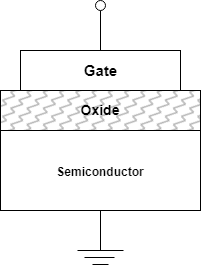NMOS Capacitor
Libraries:
Simscape /
Electrical /
Semiconductors & Converters
Description
The NMOS Capacitor block represents an N-type metal-oxide-semiconductor (NMOS) capacitor. You can parameterize this block by using MOS equation parameters or parameterize the values as a function of temperature and voltage by using a tabulated capacitance lookup table.
This figure shows the elements that comprise a MOS capacitor:

The NMOS Capacitor block uses a P-type bulk semiconductor.
Equation-Based Model
When you set the Capacitor model parameter to
Fundamental nonlinear equations, the NMOS
Capacitor block operates in three operating modes depending on the
gate-bulk voltage, Vgb, the flat-band voltage,
Vfb, and the threshold voltage,
Vth:
— Accumulation mode. The voltage on the metal plate accumulates the majority charge carriers, or the holes, of the bulk material on the surface of the semiconductor.
— Depletion mode. The applied voltage induces the minority charge carriers, or the electrons, and creates a depletion region at the surface.
— Inversion mode. The majority carrier type at the surface of the semiconductor is inverted.
To calculate the flat-band voltage, the block uses this equation:
where γ is the body factor and φ is the surface potential.
The block adjusts the value of the surface potential φ by using the equation
where:
Tsim is the value of the Device simulation temperature parameter, in Kelvin.
Tmeas is the value of the Measurement temperature parameter, in Kelvin.
EG is the value of the Band-gap energy parameter, in electron-volts. The block assumes this parameter is temperature independent.
q is the electron charge, in Coulomb, and is equal to
1.60217663e-19C.k is equal to
1.380649e-23J/K.
This equation defines the total gate charge of the capacitor,
QG,
where:
Qacc is the accumulation charge that the majority charge carriers form.
Qdep is the depletion region charge within the semiconductor layer.
Qinv is the inversion charge that the minority charge carriers form.
When the gate-bulk voltage is less than the flat-band voltage, the block enters the accumulation operating mode. In accumulation mode, the majority carriers accumulate on the surface of the semiconductor. The block calculates the accumulation, depletion, and inversion charges by using these equations:
where Cox is the total oxide capacitance.
When the gate-bulk voltage is less than the threshold gate voltage and greater than or equal to the flat-band voltage, the block enters the depletion operating mode. In depletion mode, the minority carriers stack on the surface of the semiconductor. The block calculates the accumulation, depletion, and inversion charges by using these equations:
where Cox is the total oxide capacitance and γ is the body factor.
When the gate-bulk voltage is greater than or equal to the threshold gate voltage, the block enters the inversion operating mode. In inversion mode, the majority carrier type at the surface of the semiconductor is inverted. The block calculates the accumulation, depletion, and inversion charges by using these equations:
where Cox is the total oxide capacitance, γ is the body factor, and is the gate-bulk capacitance at the inversion threshold, which is equivalent to Cox and Cdep in series. Cdep is the depletion layer capacitance.
If you select the Model high-frequency C-V behavior at strong inversion parameter, the block assumes that the minority carriers do not have enough time to react to the change in the applied voltage. Consequently, the inversion charge, Qinv is zero and the applied voltage drops across the oxide capacitance and the depletion region capacitance.
If you clear the Model high-frequency C-V behavior at strong inversion parameter, the block assumes that the minority carriers have enough time to quickly respond to the change in the voltage and form the inversion layer charge beneath the oxide layer of the MOS capacitor.
Tabulated Model
When you set the Capacitor model parameter to Lookup
table (2-D, temperature dependent), the NMOS Capacitor block tabulates the
total gate charge of the capacitor, QG, in terms
of voltage and temperature. To parameterize the block parameters as a function of
temperature and voltage by using a tabulated capacitance lookup table, specify the
Gate-bulk capacitance lookup table, Cgb(T,Vgb), Gate-bulk
voltage, Vgb, and Temperature, T parameters.
If you specify only one value in the Temperature, T parameter, the C-V characteristics of the capacitor become temperature independent.
To ensure the gate charge conservation over one full AC cycle, the block converts the Gate-bulk capacitance lookup table, Cgb(T,Vgb) parameter to an equivalent charge lookup table. The block uses this equivalent charge table to calculate the variations in the gate charge, Qg, with respect to the voltage by using linear interpolation and extrapolation methods.
Variables
To set the priority and initial target values for the block variables before simulation, use the Initial Targets section in the block dialog box or Property Inspector. For more information, see Set Priority and Initial Target for Block Variables.
Use nominal values to specify the expected magnitude of a variable in a model. Using system scaling based on nominal values increases the simulation robustness. Nominal values can come from different sources. One of these sources is the Nominal Values section in the block dialog box or Property Inspector. For more information, see System Scaling by Nominal Values.
Ports
Conserving
Parameters
Extended Capabilities
Version History
Introduced in R2024b